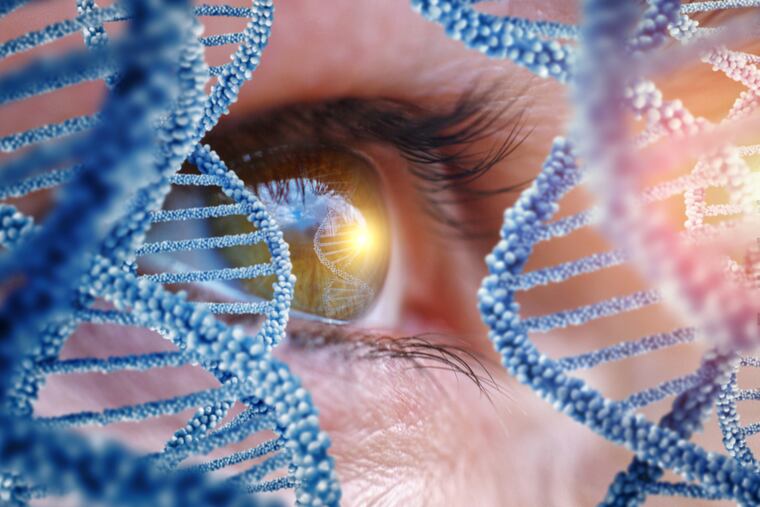Penn’s experimental gene therapy saves night vision in dogs, paving the way for human tests
In dogs, Penn's gene therapy was effective against a form of retinal disease that progressively causes blindness.

In 1990, scientists discovered a genetic mutation that turns an important light-sensing protein in the retina into a toxin that steadily destroys the ability to see in low light.
Many similar mutations have been identified since then, but there is still no way to treat or prevent the loss of night vision.
Now, University of Pennsylvania researchers have used gene therapy to do just that in a canine version of the inherited retinal disorder.
The success in six dogs paves the way for clinical trials in humans, perhaps in just a few years, and comes as gene therapy raises hopes for turning debilitating hereditary eye diseases into treatable conditions.
The trailblazing blindness drug, Luxturna — developed by Spark Therapeutics and scientists at Penn and Children's Hospital of Philadelphia — was approved last December by the U.S. Food and Drug Administration to restore some sight in a different inherited form of blindness. Gene therapy trials for a wide range of retinal diseases are underway worldwide.
The new research, published Monday in the Proceedings of the National Academy of Sciences, was conducted by Penn's School of Veterinary Medicine and the Perelman School of Medicine in collaboration with the University of Florida.
"This is a huge step forward. The study is a real tour de force," said Stephen Rose, chief scientific officer of Foundation Fighting Blindness, one of the funders of the research. "We all know that what happens in animals doesn't always translate to [human] clinical trials. But I am very optimistic."
The light-sensing protein that turns destructive is called rhodopsin. Normally, this molecule — located in the rod cells of the retina — converts dim light into electric signals that the retina sends to the brain, which interprets them as images. But in mutated form, rhodopsin ruins the rod cells.
Rhodopsin gene mutations account for about 20 percent of all cases of retinitis pigmentosa, a group of inherited retinal diseases that rob people of night and peripheral vision before progressing to blindness. That subset translates to an estimated 20,000 people in this country, Rose said.
Over the past 20 years, rhodopsin mutations have basically defied gene therapy, which involves using an inactivated virus, called a vector, to ferry corrective genetic material into cells.
One challenge has been the dominance of rhodopsin mutations; a person who inherits just one copy of the defective gene – from a father or a mother – develops the disease. What's more, about 150 mutations have been identified. Rather than try to fix them one by one, the ideal gene therapy would be one-treatment-fits-all mutations.
The Penn team accomplished that feat by disabling both the abnormal and normal copies of the rhodopsin gene – so the specific mutation didn't matter – while simultaneously providing a healthy copy to make the vital protein.
Six dogs got the therapy injected into one eye, with the other eye serving as a comparison. Sophisticated tests showed the treatment suppressed the toxic rhodopsin, and enabled production of about 30 percent of the normal level of healthy rhodopsin in rod cells. That, in turn, enabled the transmission of light signals to the brain.
"In dominant diseases, gene therapy has been much more challenging because the mutation causes a toxic 'gain of function.' It needs to be removed," said Artur V. Cideciyan, an ophthalmologist at Penn's Scheie Eye Institute and co-lead author of the paper. "Now, with these results, we can start working toward treating these mutations…in humans. A crystal ball is tricky, but we hope this could be [in human trials] in a couple years."
The latest advance was built on years of hits and misses. Initially, researchers hoped that knocking out the dogs' rhodopsin gene – without replacing it – would be enough to protect the light-sensing rod cells. That approach turned out to preserve only the outer layer of the cells.
"Without another critical layer, where rhodopsin plays the essential role of capturing light and initiating vision, then the rods become useless," explained co-lead author William A. Beltran, a veterinary ophthalmologist at Penn's vet school. "However, if you combine the knockdown with the replacement reagents, then …you have functional photoreceptor cells."
Another strategy that failed involved injecting two viral vectors – one to knock out the dogs' rhodopsin gene and another to deliver the replacement. "There was incomplete rod protection and treatment resulted in severe retinal complications," the researchers wrote.
The solution was to engineer a single vector to carry both genetic components of the therapy. The key technology came from researchers at the University of Florida in Gainesville.
Although only six dogs received the novel gene therapy, it was safe and effective in all of them, and their night vision has been stable for more than eight months.
"For 38 years, we've known one of the most common causes of retinal degeneration, and yet we've had no success in treating it," Cideciyan said. "Because of that, we think this is exciting."